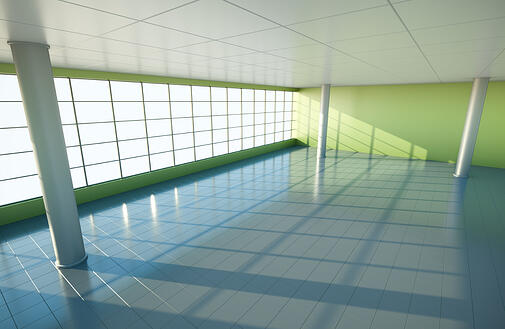 Your space is bigger than you think it is. Then again, it's also smaller than you think it is. The reason for this is that there are two different ways of measuring spaces in commercial real estate, and the difference between them can add up to thousands of dollars per year -- even on small spaces.
Your space is bigger than you think it is. Then again, it's also smaller than you think it is. The reason for this is that there are two different ways of measuring spaces in commercial real estate, and the difference between them can add up to thousands of dollars per year -- even on small spaces.
Your Usable Space
For simplicity's sake, assume that you have a rectangular space. If you take your tape measure and run it along your inside walls, you might find that your space measures 70 feet long and 50 feet wide. Simple mathematics tells you that your space measures 3,500 square feet.
This measurement is called your "usable" space, since it's the space that you actually get to control and use for yourself. In most buildings, though, it isn't the space you pay rent on.
Your Rentable Space
Commercial real estate landlords calculate rent on the basis of your rentable space, which is bigger than your usable space. Rentable space is equal to your usable space plus your pro-rata share of the common areas of your floor, not counting vertical penetrations. Vertical penetrations are holes in the floor like those for stairways or for elevator shafts.
Since this commercial real estate concept is kind of complicated, an illustration can be helpful. Imagine that the floor that holds your 3,500 square foot space holds 5 more identical spaces for a total of 21,000 usable square feet. However, the building itself measures 230 feet long and 110 feet deep for a total floor are of 25,300 square feet. Looking more closely, about 400 square feet of the building's area is taken up by stairwells and elevator shafts, leaving a total area of 24,900 square feet. The extra 3,900 square feet hold hallways, restrooms, and elevator lobbies.
To find your rentable space, you would find your pro-rata share of the floor's usable area. Since the floor has 21,000 usable square feet and you have 3,500 square feet, you have one-sixth of the space or 16.667 percent. Then, you multiply the floor's 24,900 total rentable area by your pro-rata share to find your rentable square footage. 24,900 times 0.16667 is your rentable area of 4,150 square feet. The extra 650 square feet, called a "load" or "core" factor, is your share of the building's common areas.
How Commercial Real Estate Landlords Get Away With Charging for Hallways
As a tenant, you probably don't want to pay for spaces that aren't inside your walls. However, think about what it would be like to occupy a building without those common areas. You'd have to scale the outside walls to get in your space and, if you didn't have an en-suite restroom, your employees would spend much of their time running to the nearest coffee shop, gas station or restaurant. Since you benefit from having lobbies, halls and bathrooms, your landlord asks you to pay for them.
Common Areas and Your Commercial Real Estate Space
The relative share of common area that you pay for varies depending on the type of commercial real estate you occupy. Offices with interior corridors -- like most mid- and high-rise buildings typically carry load factors and atrium buildings frequently carry very high ones. Indoor retail properties, like malls, also carry load factors. Typically, complexes with little or no shared space, like outdoor corridor garden-style office buildings, open air strip centers or industrial properties have little or no differential between rental and usable square footages, so you essentially pay for what you get.








